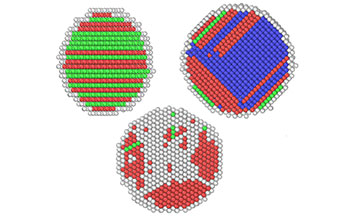Multimedia Gallery
Defect patterns in DNA-linked crystals
Defect patterns in DNA-linked crystals.
By attaching short sequences of single-stranded DNA to nanoscale building blocks, researchers can design structures that can effectively build themselves. A Pennsylvania State University research team has shown that fluid dynamics plays a critical role for crystals that self-assemble without the pattern defects seen here.
The research was supported by the National Science Foundation through its Chemical, Bioengineering, Environmental and Transport Systems Division (grants CBET 08-29045 and CBET 11-33386).
To learn more about this research, see the Penn news story The motion of the medium matters for self-assembling particles, Penn research shows. (Date image taken: unknown; date originally posted to NSF Multimedia Gallery: Nov. 10, 2015) [Image 1 of 2 related images. See Image 2.]
SORRY: THIS IMAGE IS NOT AVAILABLE IN HIGH RESOLUTION FORMAT
Credit: Ian Jenkins, University of Pennsylvania
Images and other media in the National Science Foundation Multimedia Gallery are available for use in print and electronic material by NSF employees, members of the media, university staff, teachers and the general public. All media in the gallery are intended for personal, educational and nonprofit/non-commercial use only.
Images credited to the National Science Foundation, a federal agency, are in the public domain. The images were created by employees of the United States Government as part of their official duties or prepared by contractors as "works for hire" for NSF. You may freely use NSF-credited images and, at your discretion, credit NSF with a "Courtesy: National Science Foundation" notation.
Additional information about general usage can be found in Conditions.
Also Available:
Download the high-resolution JPG version of the image. (465 KB)
Use your mouse to right-click (Mac users may need to Ctrl-click) the link above and choose the option that will save the file or target to your computer.



